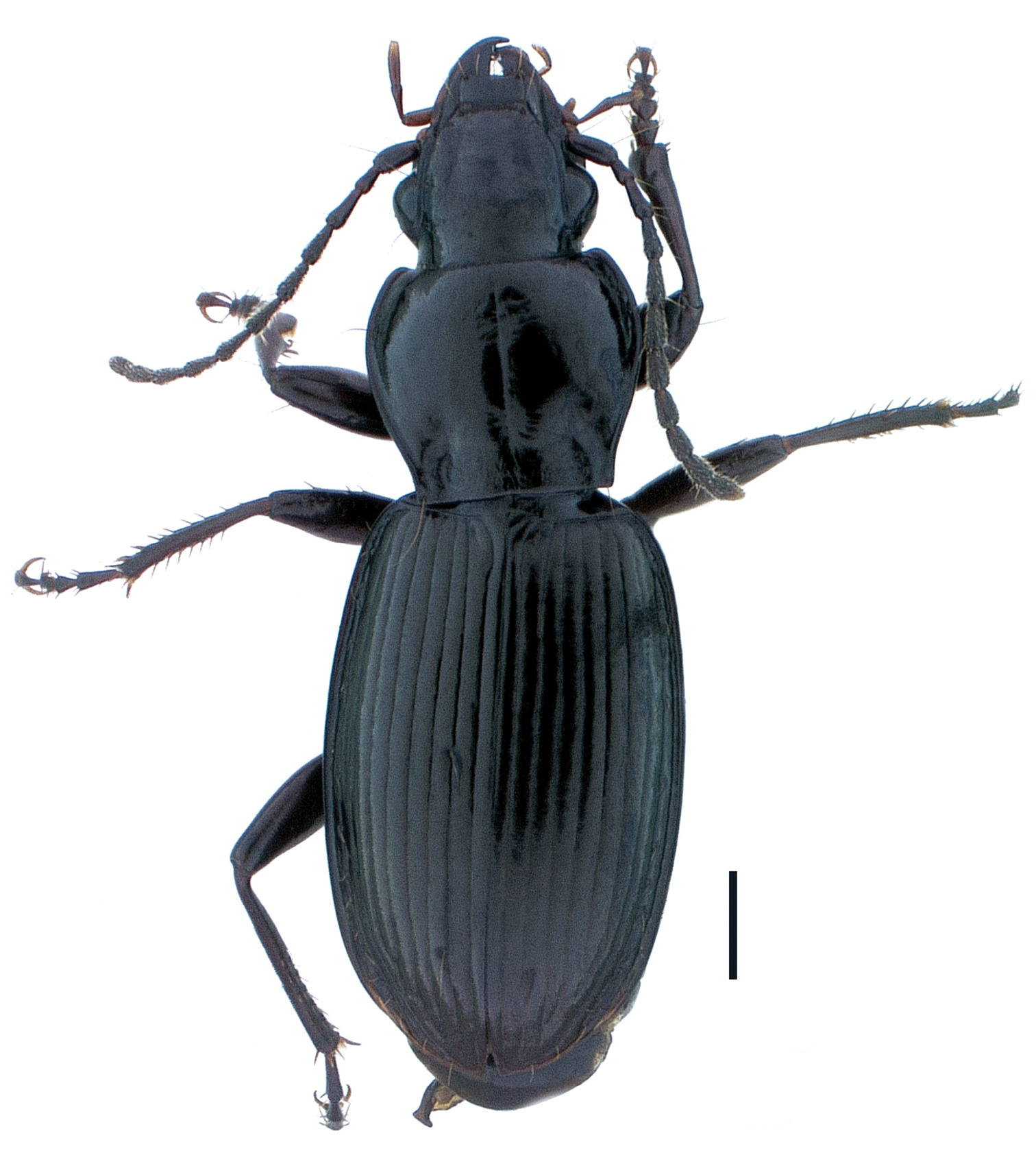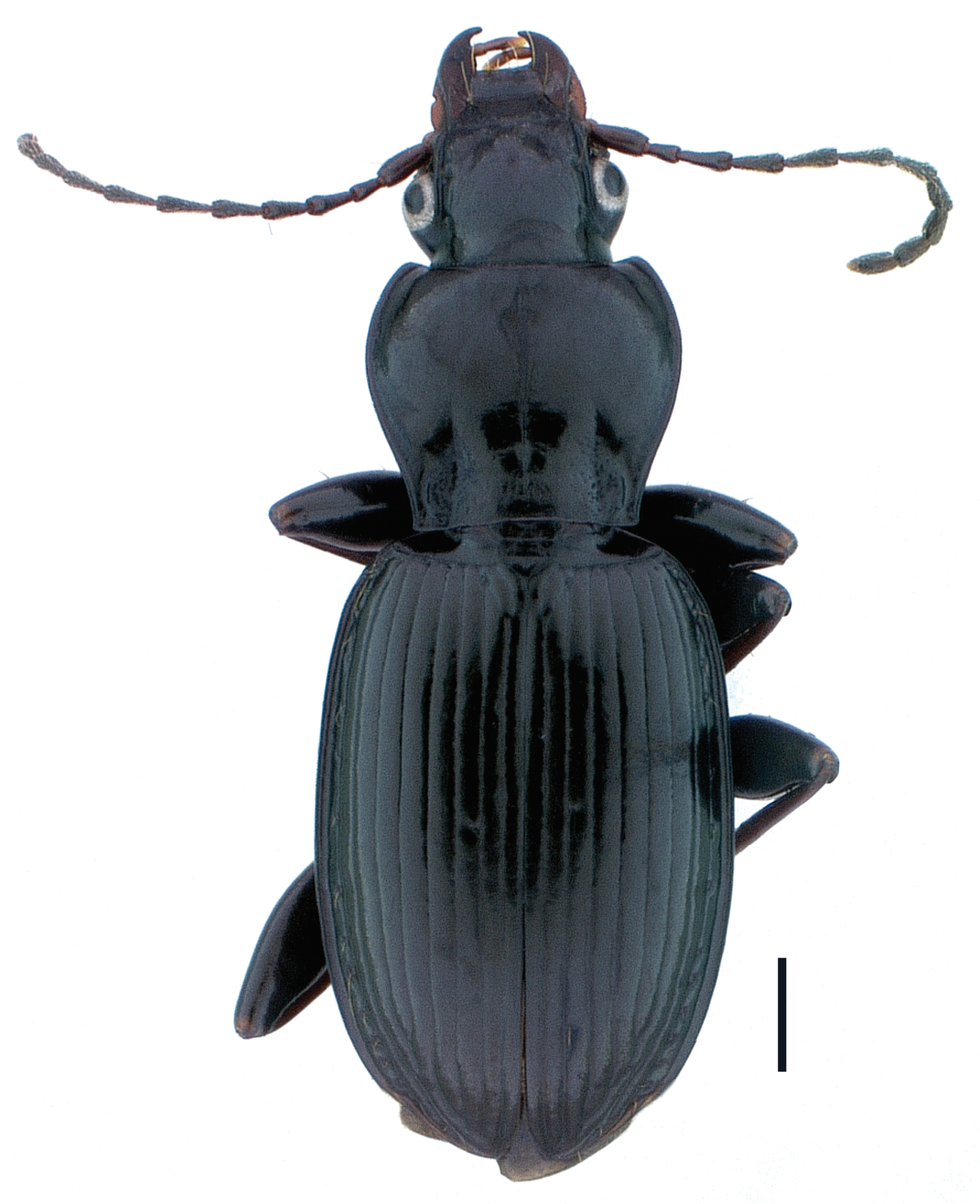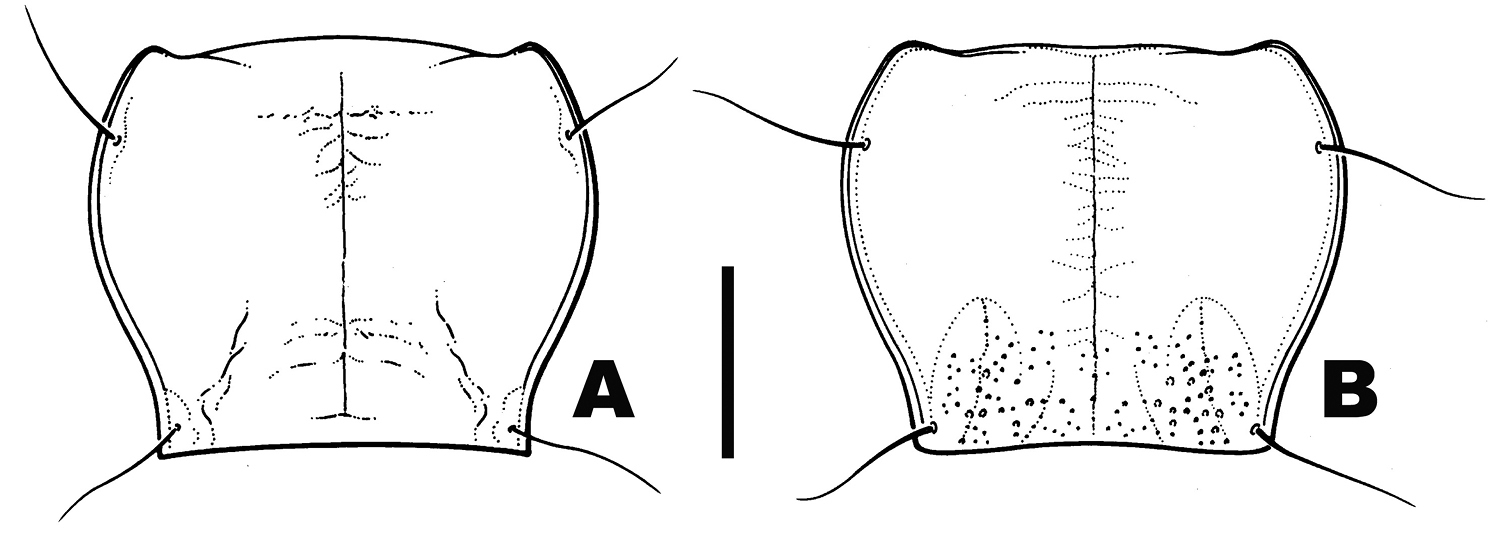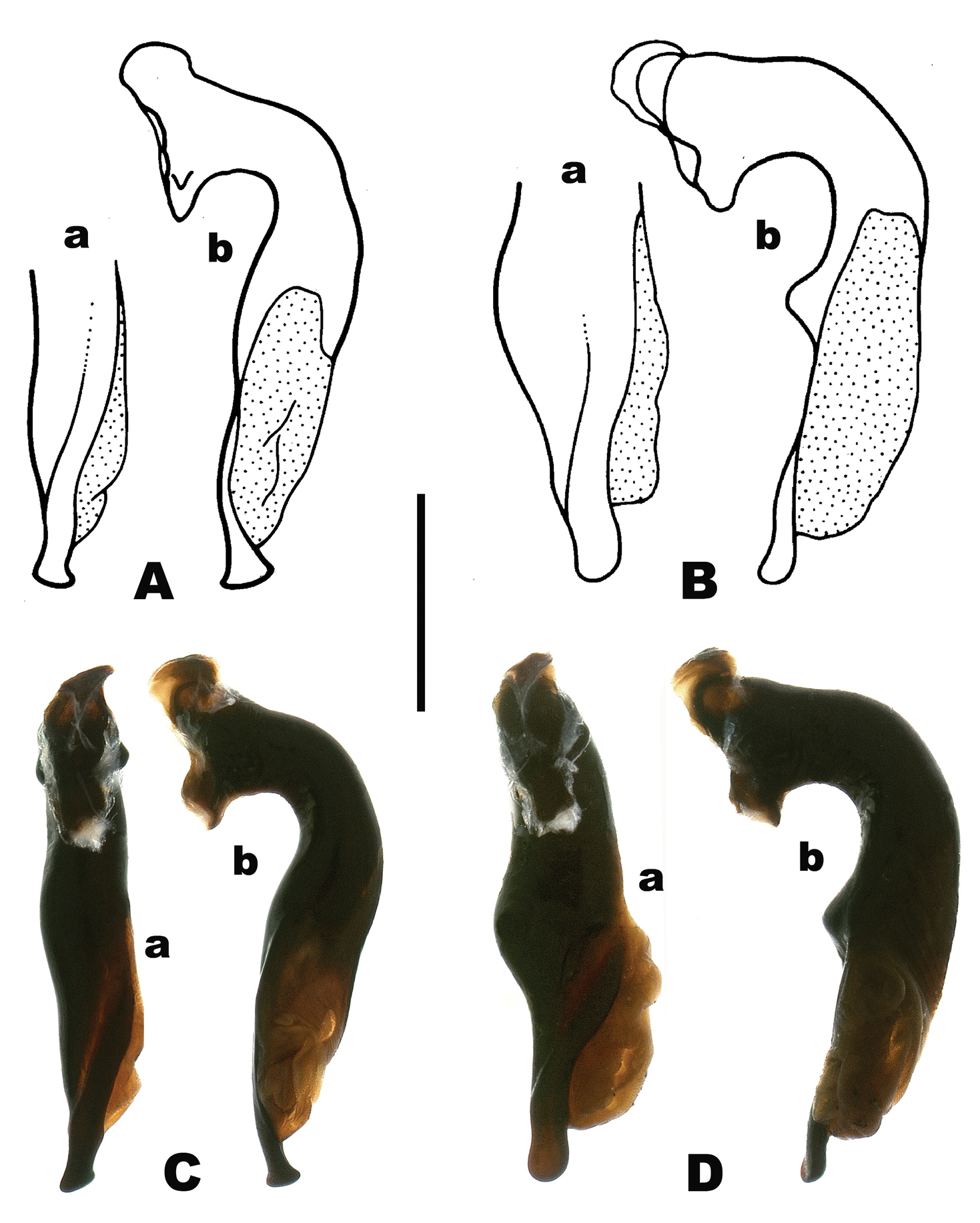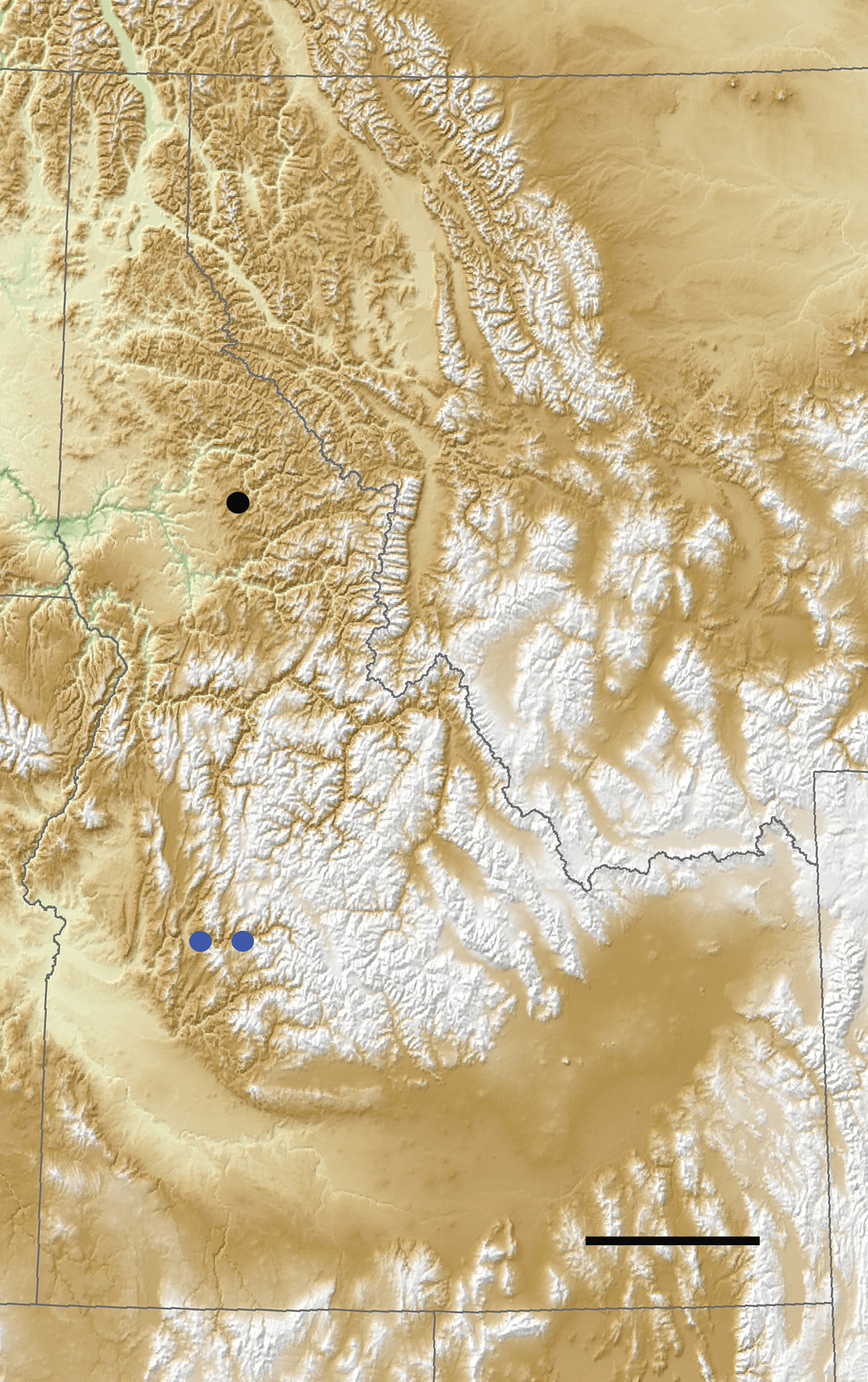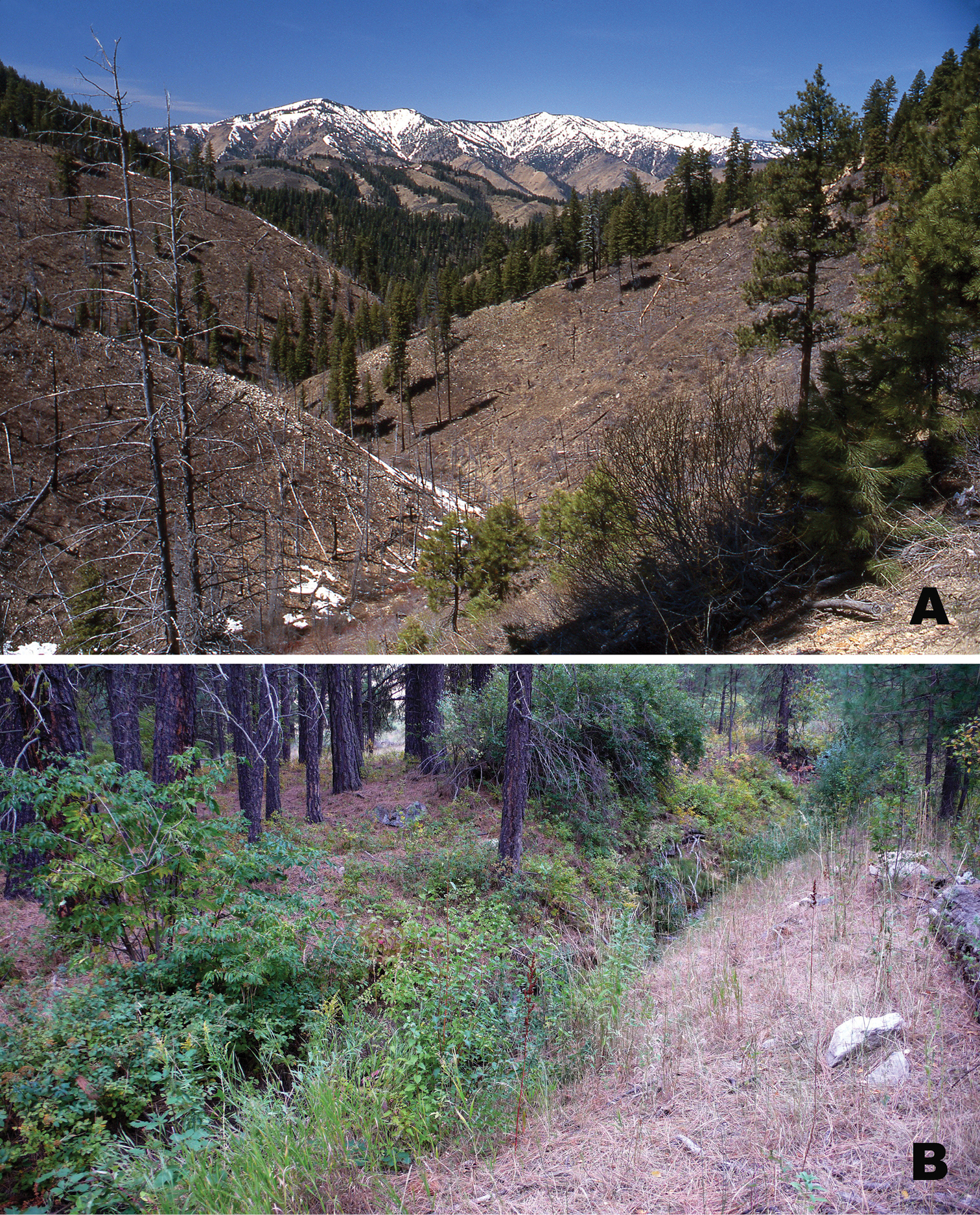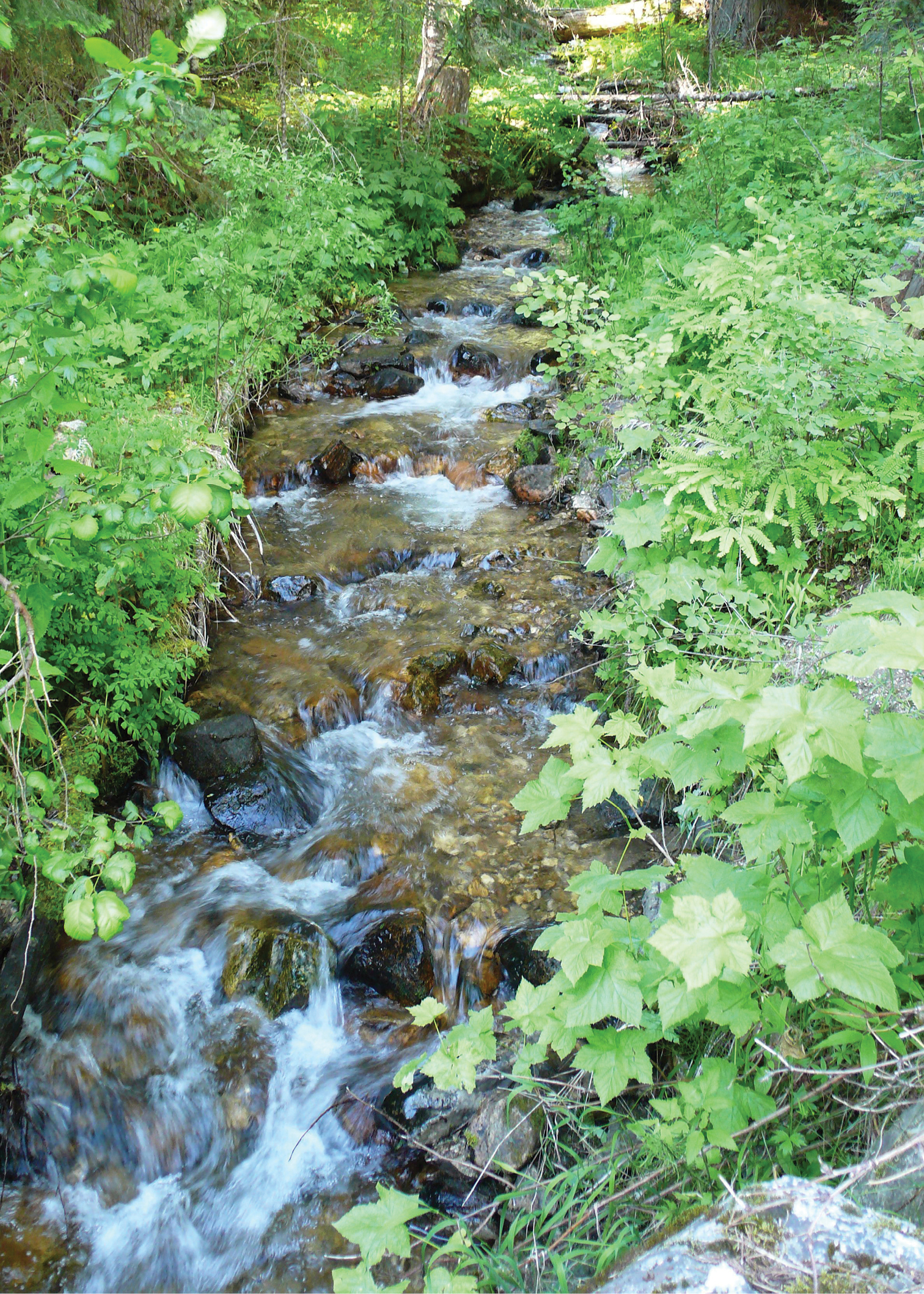






(C) 2011 James C. Bergdahl. This is an open access article distributed under the terms of the Creative Commons Attribution License, which permits unrestricted use, distribution, and reproduction in any medium, provided the original author and source are credited.
For reference, use of the paginated PDF or printed version of this article is recommended.
Two new species of Pterostichus Bonelli subgenus Pseudoferonina Ball, are described from the mountains of central Idaho: Pterostichus bousqueti Bergdahl [type locality = small tributaries of South Fork of Payette River watershed, ca. 1170 m (3840 ft), 44.0675°; -115.6822°, near Lowman, Salmon River Mountains, Boise County, Idaho, U.S.A.] and Pterostichus lolo Bergdahl [type locality = Cottonwood/Orogrande Creek, ca. 870 m (2850 ft), 46.5528°; -115.5522°, North Fork of Clearwater River watershed, Clearwater Mountains, near Bungalow, Clearwater County, Idaho, U.S.A.]. Males of Pterostichus bousqueti and Pterostichus lolo are easily distinguished from each other and the seven previously described Pseudoferonina species by the form of the median lobe of the aedeagus, and from most individuals of the other species of Pseudoferonina in Idaho by features of pronotal shape and macrosculpture. Both species appear to be obligate ripicolous hygrophiles, restricted in distribution primarily to the margins of small montane streams in forested areas. Widespread intensive stream surveys for Pseudoferonina over many years indicate the geographic ranges of both species are highly localized, and additional undescribed species may occur in Idaho.
Coleoptera, Carabidae, Pterostichus , Pseudoferonina , Melvilleus , North America, Pacific Northwest, Idaho, Salmon River Mountains, Clearwater Mountains, flightlessness, endemism, montane streams
Pterostichus
The carabid fauna of the Pacific Northwest [ca. 705 recognized species and subspecies (
Pseudoferonina includes six previously described species that appear to form a distinct group: Pterostichus lanei (
The purpose of this paper is to describe two new species of Pseudoferonina
from the Clearwater and Salmon River mountains of central Idaho,
including information about form and structure, geographical and
habitat distributions, and way of life.
All specimens of the new species described here were
collected by the first author [JCB] in 1999, 2009 or 2010. These
specimens were acquired by timed hand collecting along small streams in
mountainous terrain (e.g.,
Specimens were examined using an 8–50x Nikon dissecting scope with a high-intensity light tube. The only measurement recorded was apparent body length (ABL), measured from the apex of the labrum to the apex of the longer elytron. Digital photographs of dorsal habitus and male genitalia were taken using an Auto-montage imaging system by Syncroscopy with a Leica M420 dissecting microscope.
Specimens examined in the course of this study are deposited in the following collections:
CAS - California Academy of Sciences, San Francisco, California, U.S.A.
CMNH - Carnegie Museum of Natural History, Pittsburgh, Pennsylvania, U.S.A.
CNC - Canadian National Collection, Ottawa, Ontario, Canada
JCB - James C. Bergdahl Collection, Spokane, WA, U.S.A.
OSU - Oregon State University Arthropod Collection, Corvallis, Oregon, U.S.A.
UICM - University of Idaho, Moscow, Idaho, U.S.A.
WSU - Washington State University, Pullman, WA, U.S.A.
Taxonomyurn:lsid:zoobank.org:act:1D065517-89A3-4A7F-8025-0522484E5CEF
http://species-id.net/wiki/Pterostichus_(Pseudoferonina)_bousqueti
Figs 1, 3A, 4A, 4C, 5, 6U.S.A., Idaho, Boise County, small tributaries of the South Fork of the Payette River near Lowman, ca. 1200 m (3940 ft) elevation, 44.0675°; -115.6822°.
Holotype: a male, deposited in CAS, labeled: “USA: Boise Co., Pine Flat Creek at South Fork Payette River Road, 6 km W of Lowman, 44°04'03"N; 115°40'56"W, T9N, R7E, S31, elev. 1160 m (3805 f), South Fork Payette River Basin, Boise National Forest, 05 May 1999, #26-1999, J. C. Bergdahl, coll.”/ “HOLOTYPE Pterostichus bousqueti Bergdahl designated 2011” [red label]. Paratypes: A total of 11, with 8 males and 1 female with the same data as the holotype, and 2 males labeled: “USA: Boise Co., Archie Creek near confluence with SF Payette R., 8 km E of Lowman, Boise Natn. Forest, 44°04'15"N; 115°31'06"W, T9N R8E S33, elev. 1240 m (4070 ft), South Fork Payette R. watershed, 06 May 1999, #33-1999, J. C. Bergdahl, coll.” The single female paratype is deposited in CAS, the male paratypes in CNC, CMNH, OSU, UICM, WSU, and JCB.
The specific epithet, bousqueti, is a
Latinized version (genitive case) of the surname of Dr. Yves Bousquet
(Agriculture Canada, Ottawa, Ontario, Canada), in recognition of his
outstanding contribution (
Holotype male, Pterostichus (Pseudoferonina) bousqueti Bergdahl, sp. n., dorsal habitus. Scale line = 1.0 mm. Automontage digital image by D. H. Kavanaugh.
Holotype male, Pterostichus (Pseudoferonina) lolo Bergdahl, sp. n., dorsal habitus. Scale line = 1.0 mm. Automontage digital image by D. H. Kavanaugh.
A Pterostichus with the characteristics of members of subgenus Pseudoferonina (see
Size medium-small for subgenus, ABL males 8.5–9.5 mm, female 8.9 mm. Body form slightly slender for subgenus (Fig. 1).
Color. Dorsal body surface black and shiny, pronotal lateral beads piceous, legs, antennae and palpi piceous.
Microsculpture. Head with isodiametric meshes on frons; pronotum with faintly impressed transverse meshes on most of disc, meshes more isodiametric basolaterally; elytra with markedly transverse meshes, faintly iridescent in some areas.
Pronotum. Fig. 3A. Almost as long as wide, lateral margins subparallel anterior to hind angles, slightly sinuate, hind angles rectangular or slightly acute, lateral margins (in lateral view) bent ventrally near hind angles. Anterior and posterior transverse impressions present but faintly impressed, median line distinctly impressed, almost entire, but not quite extended to anterior and posterior margins in most specimens examined; anterior transverse impression faintly punctulate. Lateral margins finely beaded, posterior margin without margination, anterior margin minutely beaded in medial one-third. Basolateral fovea deep and broadly linear, slightly convergent toward midline anteriorly, not or only faintly punctulate.
Pronotum, dorsal aspect A Pterostichus (Pseudoferonina) bousqueti Bergdahl, sp. n. B Pterostichus (Pseudoferonina) lolo Bergdahl, sp. n. Scale line = 1.0 mm. Line drawings by Go Sato.
Elytra.Intervals flat or only slightly convex, but less so than in any other Pseudoferonina species.
Legs. Male mesotibiae slightly curved apically.
Abdomen. Last visible sternite of male with broad, shallow medial indentation, anterior margin of depression not at all carinate, sternite without protuberances; last visible sternite of males with single pair of anal setae, female with two pairs.
Male genitalia. Median lobe of aedeagus as in Figs 4A and 4C. Apical one-third of median lobe (in ventral view) with lightly sclerotized oblique band extended longitudinally next to slight ridge (Fig. 4C); shaft of median lobe (in ventral view) swollen submedially on left, with shaft gradually tapered from swelling to the apical lamella, ventral margin not sinuate subapically (in lateral view); apical lamella average in length for Pseudoferonina species in Idaho, symmetrically hatchet-shaped (in left lateral view). Right paramere short and sharply pointed.
Median lobe of male aedeagus A–B line drawings, a = apical region, ventral view; b = left lateral view C–D Automontage digital images, a = ventral view, b = left lateral view A Pterostichus (Pseudoferonina) bousqueti Bergdahl sp. n. B Pterostichus lolo Bergdahl sp. n. C Pterostichus bousqueti D Pterostichus lolo. Scale line = 1.0 mm. Line drawings by G. Sato; digital images by D. H. Kavanaugh.
At this time, Pterostichus bousqueti is known only from Pine Flat Creek and Archie Creek near their confluences with the South Fork of the Payette River near Lowman, Boise County, Idaho (Fig. 5). The Payette River is a tributary of the Snake River, which is a major tributary of the Columbia River. To what extent the range of this species is narrowly restricted to this area is not known. Despite sampling many other creeks in this area, JCB has been unable to document any other Pterostichus bousqueti populations. Additional areas, if any, in which this species is most likely to occur include the Big Pine, Deadwood, Clear Creek and Middle Fork of the Payette River watersheds to the west of Lowman and east of the North Fork of the Payette River.
Toporelief map of Idaho illustrating the locations of known localities for Pterostichus (Pseudoferonina) bousqueti Bergdahl, sp. n. (blue dots) and Pterostichus lolo Bergdahl sp. n. (black dot). Scale line = 100 km.
The type locality along the South Fork of the Payette River near Lowman is in a steeply sided, sparsely pine-forested gorge (Fig. 6A)
that has experienced intense forest fires. From 1908 to 2000, canopy
fires burned more than 50% of the Boise National Forest in central
Idaho. Large fires have a huge effect on vegetation, geomorphology,
stream hydrographs (
Photographs of habitat for Pterostichus (Pseudoferonina) bousqueti Bergdahl, sp. n. A View north over South Fork Payette River gorge toward Deadwood Ridge above Lowman, Boise County, Idaho, 5 May 1999 B Pine Flat Creek, near Lowman, Boise County, Idaho, 25 September 2008. Photographs by J. C. Bergdahl.
Both Pine Flat Creek (Fig. 6B) and Archie Creek are small, perennial streams descending steep canyon slopes. Their lower sections run thru dry open ponderosa pine forests. At higher elevations on sun and wind-exposed south-facing slopes, the vegetation is primarily open scrub. Pine Flat Creek descends a steep scrubby hillside; pine forest is restricted to lower reaches near the Payette River. Archie Creek descends its watersheds at a gentler grade. Both of these creeks near their confluence with Payette River are only about 1.5 m bank-full-width, and are confined primarily to channels with stabilized vegetated banks. Consequently, there are very few gravel bars on which to search for beetles, even at low water. High water for these creeks most likely occurs March-May, during rapid melt of the snow at higher elevations on adjacent hillsides coincident with wet spring storms. Because the watersheds these creeks service are so small, large thunderstorms and cloudbursts, by themselves, also may cause significant peaks in runoff during summer and fall months after the snow pack has melted at high elevation. In exceptionally dry years, both of these creeks may actually dry up to the extent that even lower sections are without surface-flowing water. However, on 25 September (2008) both creeks had nearly one meter of surface water stream width. Given their small watersheds, it is likely that major sections of both streams, especially high up where slopes are steep and the vegetation scrubby, dry up even in average years.
Other carabid species collected by JCB at or near the type locality include: forest habitat - Psydrus piceus LeConte, Pterostichus protractus LeConte; streamside habitats - Platynus brunneomarginatus (Mannerheim), Bembidion iridescens LeConte, Bembidion kuprianovi Mannerheim, Bembidion sp., Diplous aterrimus (Dejean), Nebria sp., Bradycellus californicus (LeConte), Bradycellus nigrinus (Dejean), Bradycellus nubifer LeConte. The trout-stream beetle Amphizoa insolens LeConte (Coleoptera, Amphizoidae) also occurs along creeks in this area.
JCB visited Pine Flat Creek and Archie Creek on two occasions: 05–06 May (1999) and 25 September (2008). In early May, he easily found adults of Pterostichus bousqueti at both sites, however in September collecting along these same stream sections on both creeks yielded no specimens. Pseudoferonina populations in hot dry regions at low elevations appear to aestivate or go into early hibernation, probably in August. Very few teneral specimens have been collected; however, males with soft, poorly chitinized median lobes are common in late summer and fall. This suggests that adults emerge from pupal chambers in late summer through early fall and overwinter as adults. Presumably they escape winter-spring floods by migrating out of the floodplain to higher positions along stream banks to hibernate in the fall before freeze-up, however they probably do not go very far. Once snow packs melt and daytime temperatures approach 10°C (late March and early April at lower elevations in Idaho), adults again become active on the surface. Given the fact that surface-active Pseudoferonina adults are so closely associated with the immediate vicinity of stream margins, the larvae are probably also narrowly restricted to these habitats and may spend a substantial amount of time subsurface at or very near the hyporheic zone.
All known individuals are brachypterous (flightless) and restricted to the margins of small, isolated, forested streams, so dispersal power of Pterostichus bousqueti adults is expected to be extremely low. Like Pterostichus shulli, Pterostichus spathifer and Pterostichus lolo sp. n., the geographic range of Pterostichus bousqueti (Fig. 5) appears to be highly restricted.
Among Idaho’s Pseudoferonina species, Pterostichus bousqueti appears to be a member of the lanei species-group (with Pterostichus lanei), as opposed to the shulli species-group (Pterostichus shulli, Pterostichus spathifer and Pterostichus lolo sp. n.). Idaho species in the shulli group have a distinct ventral sinuation (bulge and concavity) on the ventral surface of the median lobe of the aedeagus near the middle of the shaft (easily seen in lateral view). Species in the lanei group (and Pterostichus vexatus) do not have this feature. To what extent this feature, or its absence, is indicative of phylogenetic relationship is presently unknown.
Property ownership in the South Fork Payette River area in vicinity of the type locality is primarily the U.S. Forest Service (Boise National Forest), however according to the Boise National Forest map there are many small in-holdings along the river. Two of these in-holdings include both lower Pine Flat and lower Archie creeks, near where the type specimens were collected. Both of these creeks probably have experienced prospecting or mining activity. There is a small Forest Service campground and hot springs very near Pine Flat Creek on the north bank of the Payette River, but visitors seem to have little impact on the creek.
Because Pterostichus bousqueti is known from only two easily identifiable localities, we hope that collectors will exercise restraint when sampling at these sites, and instead focus on discovering new sites for this species in the immediate vicinity, such as in those watersheds listed above.
urn:lsid:zoobank.org:act:50D61144-E2F2-40FB-9A04-FFB9E348C458
http://species-id.net/wiki/Pterostichus_(Pseudoferonina)_lolo
Figs 2, 3B, 4B, 4D, 5, 7U.S.A, Idaho, Clearwater County, Cottonwood Creek near the confluence of Orogrande Creek and the North Fork of the Clearwater River, ca. 870 m (2860 ft) elevation, 46.5528°; -115.5522°.
Holotype, a male, deposited in CAS, labeled: “USA: IDAHO, Clearwater Co.; Cottonwood Creek @ USFS Rd 250; Orogrande Ck. Rd.; NF Clearwater R. watershed; elev. ~870 m (2860 ft); 12.5 MI. ESE Headquarters, 3.5 MI. SW of Bungalow; 46°33'10"N, 115°33'08"W; T38N, R7E, S34; 17 July 2009; #73-2009; J. C. Bergdahl, coll.”/ “HOLOTYPE Pterostichus lolo Bergdahl designated 2011” [red label]. Paratypes: A total of 22 paratypes from same locale as the holotype (7 males and 5 females from 17 July 2010; 2 males and 9 females from 03 July 2010) deposited in CAS, CMNH, CNC, JCB, OSU, UICM and WSU.
Photographs of habitat for Pterostichus (Pseudoferonina) lolo Bergdahl, sp. n. Cottonwood Creek, near Bungalow, Clearwater County, Idaho, 3 July 2010. Photograph by J. C. Bergdahl.
The specific epithet, lolo, is a noun in apposition, and refers to the Lolo Trail, an ancient hunting and trade route developed by the Nez Perce tribe to cross the Bitterroot Mountains from their homelands on the Clearwater River near Kamiah, Idaho, to the buffalo herds of Montana. The beginning of this trail in its western foothills starts in the upper Lolo River watershed, near the type locality of Pterostichus lolo. The Lolo Trail is also the route the Lewis and Clark Expedition took over the Bitterroot Mountains heading west in September 1805 and east in June 1806.
A Pterostichus with the characteristics of members of subgenus Pseudoferonina (see
Size medium-large for subgenus, ABL males = 9.5–10.5 mm, females = 9.0–10.3 mm. Body form average for subgenus (Fig. 2).
Color. Dorsal surface black and shiny, pronotal lateral beads piceous, antennae and palpi rufous or rufopiceus, femora piceous except distally rufopiceous, tibiae and tarsi rufopiceus or rufous.
Microsculpture. Head with faintly impressed isodiametric meshes on frons; pronotum with moderately impressed transverse meshes on most of disc, meshes more isodiametric posteriorly; elytra with moderately impressed transverse meshes and very slight iridescence. Pronotum. Fig. 3B. Almost as long as wide, widest point approximately at anterior one-third, lateral margins slightly sinuate in posterior half, almost parallel before hind angles, hind angles slightly obtuse to subrectangular, lateral margins (in lateral view) bent ventrally near hind angles, basal one-quarter of pronotum finely but distinctly punctate. Anterior and posterior transverse impressions faintly or not at all impressed, median longitudinal impression distinctly impressed, nearly extended to anterior and posterior margins in most specimens examined. Lateral margins finely beaded, posterior margin without margination, anterior margin minutely beaded in lateral thirds, without margination in medial one-third. Basolateral fovea deep and broadly linear, slightly convergent toward midline anteriorly, finely but distinctly punctate, areas between basal fovea and lateral margins convex, subcarinate.
Elytra. Intervals nearly flat, striae entire, moderately impressed, not or only very faintly punctulate. Legs. Male mesotibiae slightly curved apically. Abdomen. Last visible sternite of male with broad, shallow medial indentation, anterior margin of depression slightly carinate, sternite without protuberances; last visible sternite of males with single pair of anal setae, female with two pairs.
Male genitalia. Median lobe of aedeagus as in Figs 4B and 4D. Apical one-third of median lobe (in ventral view) with lightly sclerotized oblique band extended longitudinally next to slight ridge (Fig. 4Da); shaft of median lobe (in ventral view) markedly swollen submedially on left, with shaft abruptly tapered from swelling to the apical lamella, ventral margin distinctly sinuate subapically (in lateral view) with markedly abrupt, subtuberculate convexity basad of sinuation (Fig. 4Db); apical lamella average in length for Pseudoferonina species in Idaho, apex evenly rounded, very slightly swollen in ventral view (Fig. 4Da), narrow and very slightly reflexed ventrally at tip in lateral view (Fig. 4Db). Right paramere as illustrated by Bousquet (1992, Figs 15b and 16b) for Pterostichus spathifer and Bembidion shulli.
Currently, Pterostichus lolo is known only from the type locality on Cottonwood Creek (at 870 m), which is a small, low-order tributary of Orogrande Creek, which is itself a tributary of the North Fork of the Clearwater River. In turn, the Clearwater is a tributary of the Snake River, which is a major tributary of the Columbia River. To what extent the range of this species is narrowly restricted to this area is not known. Despite sampling many other creeks in this area over the past decade, JCB has been unable to document any other Pterostichus lolo populations.
The type locality is in the Clearwater Mountains and Breaks section of the Northern Rockies eco-region (
These mountains have been largely unglaciated and
support a highly dissected stream network of ancient narrow valleys and
canyons. Drainage density (length of stream/area) is high. The natural
vegetation is primarily a very species-rich mosaic of mesic conifer
forest, including exceptional conifer species diversity (grand fir,
Douglas fir, western red cedar, western hemlock, mountain hemlock,
ponderosa pine, lodgepole pine, white pine, western larch, subalpine
fir, Englemann spruce and yew). Ponderosa pine/Douglas fir and
cedar/hemlock/pine forests occur at lower elevations, and spruce/fir or
mountain hemlock forests at higher elevations. Some of the forest types
in this area are the best examples of inland temperate rainforest in
the Rocky Mountain region (
Like all other species of Pseudoferonina, Pterostichus lolo appears to be a habitat specialist, primarily on the wet margins of small, low (0-2) order forest streams descending hillsides in mountainous country. These habitats are often isolated in headwater basins, or on breaks and canyon walls at lower elevations. These beetles are not aquatic, but they are strict hygrophiles. Surface-active adults are usually found within two meters of wet stream channels, primarily within one meter of the strandline and especially right at the water’s edge. When disturbed during warm weather, they will often run into the water and crawl down into the gravel or float away.
Other carabid species collected by JCB at or in the vicinity of the Cottonwood Creek locality include: Scaphinotus (Pseudonomaretus) regularis (LeConte), Scaphinotus (Pseudonomaretus) relictus (Horn), Scaphinotus (Pseudonomaretus) merkelli (Horn), Zacotus matthewsii LeConte, Trechus coloradense Schaeffer, Bembidion kuprianovi, Bembidion iridescens, Bembidion breve (Motschulsky), Pterostichus (Hypherpes) ecarinatus Hatch, Pterostichus (Leptoferonia) idahoae Csiki, Pterostichus (Leptoferonia) beyeri Van Dyke, Pterostichus (Pseudoferonina) shulli (Hatch) and Pterostichus (Pseudoferonina) vexatus Bousquet.
Adults of Pterostichus lolo
are probably active from the first warm days of spring after snowmelt
to the first days of hard frosts in October. A single pair of adults was
observed in copulo, on 17 July 2009 [JCB]. Pterostichus lolo, and all other Pseudoferonina species, are probably “spring breeders” (
All known individuals are brachypterous (flightless) and restricted to the margins of a small, isolated, forested stream, so dispersal power of Pterostichus lolo adults is expected to be extremely low. Like Pterostichus shulli, Pterostichus spathifer and Pterostichus bousqueti sp. n., the geographic range of Pterostichus lolo (Fig. 5) appears to be highly restricted.
Based on the form of the median lobe of the male aedeagus, members of Pterostichus lolo appear to be most closely related to those of Pterostichus shulli and Pterostichus spathifer, (i.e., the shulli species-group). It is perhaps significant that both of these species, along with the more distantly related Pterostichus vexatus, occur in areas near the single known locality for Pterostichus lolo. The North Fork Clearwater River basin has the highest diversity of Pseudoferonina species.
Property ownership in the vicinity of type locality is primarily the U.S. Forest Service (Clearwater National Forest). Potlatch Corporation, Bennett Tree Farms, Inc. and the State of Idaho also have significant property ownership in this region. The primary land use impacts in this area are timber harvesting, roads, mining and off-road vehicle use. There is a large, poorly managed campground on U.S. Forest Service property along both sides of Cottonwood Creek at the type locality, with substantial off-road vehicle impacts.
Because Pterostichus lolo is known from only one, easily identifiable locality, we hope that collectors will exercise restraint when sampling at this site, and instead focus on discovering new sites for this species in the immediate vicinity.
Bousquet’s key for identification of Pseudoferonina adults (
Males of both Pterostichus bousqueti and Pterostichus lolo key to couplet “3” in Bousquet’s 1985 key. In 1992, he expanded this couplet to accommodate the new species, Pterostichus spathifer Bousquet by adding a couplet “3'”. We suggest the following additional modification to accommodate the two new species described here:
| 3 | Median lobe of aedeagus strongly sinuate on ventral margin behind middle in left lateral view | 3a |
| – | Median lobe of aedeagus not or very slightly sinuate on ventral margin behind middle in left lateral view | 3c |
| 3a | Median lobe of aedeagus with apical lamella wide, spoon-like, slightly distorted to right in left lateral view (see Bousquet, 1992, Fig. 15) | Pterostichus spathifer Bousquet |
| – | Median lobe of aedeagus with apical lamella narrower, not spoon-like (see Bousquet, 1992, Fig. 15 and Figs 4B and 4D here) | 3b |
| 3b | Median lobe with a broad, evenly arcuate convexity on ventral margin at middle in left lateral view (see Bousquet, 1992, Fig. 16) | Pterostichus shulli (Hatch) |
| – | Median lobe with an abrupt, nearly tuberculate convexity on ventral margin at middle in left lateral view (Figs 4B and 4D) | Pterostichus lolo Bergdahl sp. n. |
| 3c | Specimen larger, ABL greater than 10.5 mm; apical lamella of male median lobe nearly parallel-sided, narrow in left lateral view (see Bousquet, 1985, Fig. 9b) | Pterostichus lanei Van Dyke |
| – | Specimen smaller, ABL less than 9.6 mm; apical lamella of male median lobe expanded apically, symmetrically hatchet-shaped in left lateral aspect (Figs 4A and 4C) | Pterostichus bousqueti Bergdahl sp. n. |
The carabid fauna of the Pacific Northwest (PNW) of North
America is highly distinctive, with many endemic and taxonomically
isolated taxa, some of which have close affinities (particularly at the
generic level) with the southeastern United States or southeast Asia,
especially China and Japan (
All nine described species in the Pterostichus subgenus Pseudoferonina
are endemic to the PNW. No other group of closely related carabid
species includes so many endemics restricted to the region. The large
carabid genera Nebria Latreille and Bembidion Latreille have 13 and 9 species endemic to PNW respectively, but these species represent several subgenera (
The geographical ranges of all Pseudoferonina species remain incompletely known and/or circumscribed. The larvae of all species remain to be recognized and described. Perhaps most importantly, no sister group for Pseudoferonina has been identified and phylogenetic relationships among included species have not yet been analyzed. Without a robust hypothesis of relationship among the species, interpretation of the evolution, diversification and history of the group remains impossible. These gaps in our knowledge serve as obstacles to a better understanding of the group and prevent us from answering, at least for the present, interesting questions that should guide future research: What historical and ecological factors are responsible for the diversification of so many localized Pseudoferonina species? What is the significance of the disjunct distribution of Pseudoferonina in coastal versus inland forest regions? What can an understanding of the phylogenetic and biogeographic history of Pseudoferonina tell us about other unique elements of the Pacific Northwest’s insect fauna and their conservation? Hopefully, future discoveries and analyses will help us to answer such questions.
Without Dr. Y. Bousquet’s (CNC) advice and encouragement, JCB would most likely never have discovered either of the new species reported in this paper. We thank Y. Bousquet, Robert Davidson (CMNH) Frank Merickel (UICM), and Richard Zack (WSU), who loaned the specimens of Pseudoferonina in their care for this study, and Go Sato (CNC), who provided the line drawings. Drafts of this report were improved by critical review by Glada McIntyre. Some of the work supporting this project was part of doctorate dissertation research by JCB at the University of Washington Zoology Department and Friday Harbor Laboratories.
Table of localities. (doi: 10.3897/zookeys.104.1272.app1) File format: Microsoft Office Excel.
Copyright notice: This dataset is made available under the Open Database License (http://opendatacommons.org/licenses/odbl/1.0/). The Open Database License (ODbL) is a license agreement intended to allow users to freely share, modify, and use this Dataset while maintaining this same freedom for others, provided that the original source and author(s) are credited.
